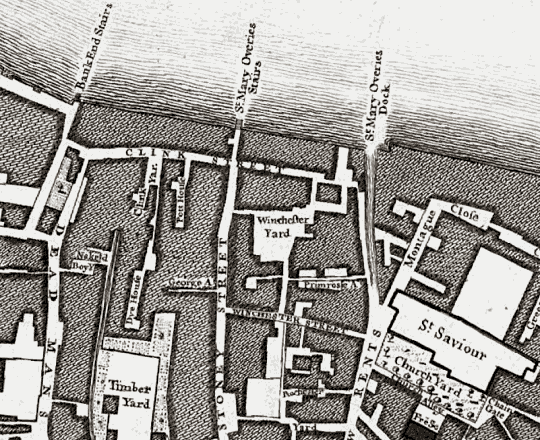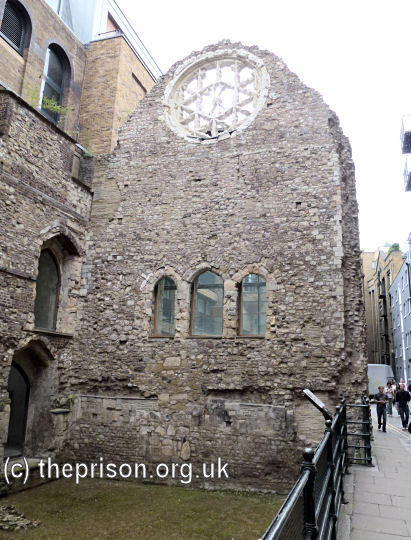The Clink Prison, Southwark, London
In 1107, construction began of a new palace, chapel, and two prisons (one for men and one for women), on land in Southwark, owned by the Bishop of Winchester, the area later becoming known as the Liberty of the Clink.
The prison locale is shown on the 1746 map below.

The Clink Prison site, Southwark, c.1746.
The prison site was attacked and seriously damaged during the Peasants' Revolt in 1381) and Jack Cade's Rebellion in 1450. In each case, the buildings were reinstated.
By around 1500, the prison had become known simply as 'The Clink' — a name that became a popular synonym for a prison. Although it was used for the detention of local breakers of the peace, the Clink was particularly employed for holding religious offenders, both priests and lay recusants.
The Oath of Allegiance, introduced under James I in 1606, allowed Roman Catholics to acknowledge their loyalty to the English king as head of the realm in what some viewed as a less objectionable way to that required by Henry VIII's Oath of Supremacy. In the years that followed, a number of Catholic priests who took this path, despite a prohibition by the Pope, were housed in the Clink, notably the archpriest George Blackwell, who died there in 1613.
During the English civil war, the Clink was used as a prison for Royalists. The Bishop of Winchester's properties were sold off and the Clink was then used to house a few debtors.
The prison was burnt down in the Gordon Riots of 1780 and was not rebuilt.
All that now survives of the buildings is part of the palace's Great Hall.

Remains of Southwark Palace Great Hall, 2011. © Peter Higginbotham
The Clink Prison Museum exhibition is located on Clink Street, near to the original site.
Records
Note: many repositories impose a closure period of up to 100 years for records identifying individuals. Before travelling a long distance, always check that the records you want to consult will be available.
- No individual records identified for this establishment — any information welcome.
- The National Archives, Kew, Richmond, Surrey, TW9 4DU. Has a wide variety of crime and prison records going back to the 1770s, including calendars of prisoners, prison registers and criminal registers.
- Find My Past has digitized many of the National Archives' prison records, including prisoner-of-war records, plus a variety of local records including Manchester, York and Plymouth. More information.
- Prison-related records on
Ancestry UK
include Prison Commission Records, 1770-1951
, and local records from London, Swansea, Gloucesterhire and West Yorkshire. More information.
- The Genealogist also has a number of National Archives' prison records. More information.
Bibliography
- Higginbotham, Peter The Prison Cookbook: A History of the English Prison and its Food (2010, The History Press)
- Brodie, A. Behind Bars - The Hidden Architecture of England's Prisons (2000, English Heritage)
- Brodie, A., Croom, J. & Davies, J.O. English Prisons: An Architectural History (2002, English Heritage)
- Harding, C., Hines, B., Ireland, R., Rawlings, P. Imprisonment in England and Wales (1985, Croom Helm)
- McConville, Sean A History of English Prison Administration: Volume I 1750-1877 (1981, Routledge & Kegan Paul)
- Morris, N. and Rothman, D.G. (eds.) The Oxfod History of the Prison (1997, OUP)
- Pugh R.B. Imprisonment in Medieval England (1968, CUP)
Links
- Prison Oracle - resources those involved in present-day UK prisons.
- GOV.UK - UK Government's information on sentencing, probation and support for families.
Except where indicated, this page () © Peter Higginbotham. Contents may not be reproduced without permission.



